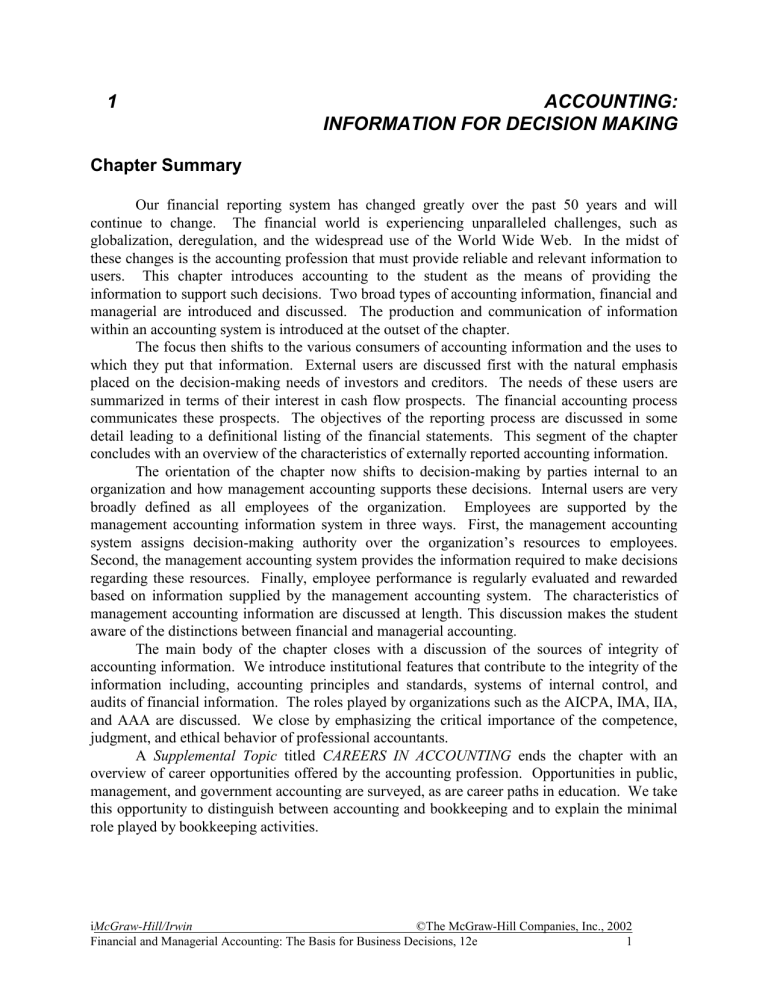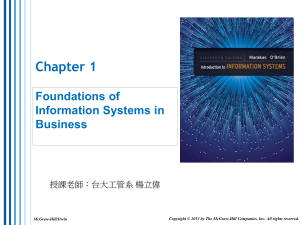
1 ACCOUNTING: INFORMATION FOR DECISION MAKING Chapter Summary Our financial reporting system has changed greatly over the past 50 years and will continue to change. The financial world is experiencing unparalleled challenges, such as globalization, deregulation, and the widespread use of the World Wide Web. In the midst of these changes is the accounting profession that must provide reliable and relevant information to users. This chapter introduces accounting to the student as the means of providing the information to support such decisions. Two broad types of accounting information, financial and managerial are introduced and discussed. The production and communication of information within an accounting system is introduced at the outset of the chapter. The focus then shifts to the various consumers of accounting information and the uses to which they put that information. External users are discussed first with the natural emphasis placed on the decision-making needs of investors and creditors. The needs of these users are summarized in terms of their interest in cash flow prospects. The financial accounting process communicates these prospects. The objectives of the reporting process are discussed in some detail leading to a definitional listing of the financial statements. This segment of the chapter concludes with an overview of the characteristics of externally reported accounting information. The orientation of the chapter now shifts to decision-making by parties internal to an organization and how management accounting supports these decisions. Internal users are very broadly defined as all employees of the organization. Employees are supported by the management accounting information system in three ways. First, the management accounting system assigns decision-making authority over the organization’s resources to employees. Second, the management accounting system provides the information required to make decisions regarding these resources. Finally, employee performance is regularly evaluated and rewarded based on information supplied by the management accounting system. The characteristics of management accounting information are discussed at length. This discussion makes the student aware of the distinctions between financial and managerial accounting. The main body of the chapter closes with a discussion of the sources of integrity of accounting information. We introduce institutional features that contribute to the integrity of the information including, accounting principles and standards, systems of internal control, and audits of financial information. The roles played by organizations such as the AICPA, IMA, IIA, and AAA are discussed. We close by emphasizing the critical importance of the competence, judgment, and ethical behavior of professional accountants. A Supplemental Topic titled CAREERS IN ACCOUNTING ends the chapter with an overview of career opportunities offered by the accounting profession. Opportunities in public, management, and government accounting are surveyed, as are career paths in education. We take this opportunity to distinguish between accounting and bookkeeping and to explain the minimal role played by bookkeeping activities. iMcGraw-Hill/Irwin ©The McGraw-Hill Companies, Inc., 2002 Financial and Managerial Accounting: The Basis for Business Decisions, 12e 1 Learning Objectives 1. Discuss accounting as the language of business and the role of accounting information in making economic decisions. 2. Discuss the significance of accounting systems in generating reliable accounting information. 3. Explain the importance of financial accounting information for external parties – primarily investors and creditors – in terms of the objectives and the characteristics of that information. 4. Explain the importance of managerial accounting information for internal parties – primarily management – in terms of the objectives and the characteristics of that information. 5. Discuss elements of the system of external and internal financial reporting that create integrity in the reported information. 6. Identify and discuss several professional accounting organizations that play important roles in preparing and communicating accounting information. 7. Discuss the importance of personal competence, professional judgment, and ethical behavior on the part of accounting professionals. *8. Describe various career opportunities in accounting. Brief Topical Outline A B C Accounting information: a means to an end 1 Accounting from a user's perspective 2 Types of accounting information a Financial accounting – see Case in Point (page 5) b Managerial accounting c Tax accounting Accounting systems 1 Determining information needs 2 The cost of producing accounting information 3 Basic functions of an accounting system 4 Who designs and installs accounting systems Financial accounting information 1 External users of accounting information 2 Objectives of external financial reporting - see Case in Point and Your Turn (page 10) a Provide information about economic resources, claims to resources, and changes in resources and claims McGraw-Hill/Irwin 2 ©The McGraw-Hill Companies, Inc., 2002 Instructor’s Resource Manual b Provide information useful in assessing amount, timing, and uncertainty of future cash flows c Provide information useful in making investment and credit decisions 3 Characteristics of externally reported information a Financial reporting-a means b Financial reporting versus financial statements c Historical in nature d Inexact and approximate measures e General-purpose assumption f Usefulness enhanced via explanation D Management accounting information 1 Internal users of accounting information – see Case in Point (page 14) 2 Objectives of management accounting – see Your Turn (page 16) 3 Characteristics of management accounting information a Importance of timeliness b Identity of decision maker - see Case in Point (page 17) c Oriented toward the future d Measures of efficiency and effectiveness e Managerial accounting information - a means E Integrity of accounting information 1 Institutional features a Standards for the preparation of accounting information b Financial Accounting Standards Board - see Case in Point (page 19) c Securities and Exchange Commission d Internal control structure e Audits of financial statements (see Case in Point - page 20) 2 Professional organizations – AICPA, IMA, IIA, AAA 3 Competence, judgment, and ethical behavior – see Your Turn (page 23) Supplemental Topic F Careers in accounting 1 Public accounting 2 Management accounting a Financial forecasting b Cost accounting c Internal auditing 3 Governmental accounting a The GAO b The IRS c The SEC 4 Accounting education 5 What about bookkeeping? 6 Accounting as a stepping-stone iMcGraw-Hill/Irwin ©The McGraw-Hill Companies, Inc., 2002 Financial and Managerial Accounting: The Basis for Business Decisions, 12e 3 Topical Coverage and Suggested assignment Homework Assignment (To Be Completed Prior to Class) Class Meetings On Chapter 1 2 Topical Outline Coverage A-C D-F Discussion Questions 5, 9, 15, 16 Exercises 4, 5, 7, 9, 10, 12 Problems n.a. n.a. Cases Internet 5 1 Comments and Observations Teaching objectives for Chapter 1 Chapter 1 introduces students to the users of accounting information, both external and internal to the organization. The objectives and characteristics of externally reported and internal accounting information are explained and contrasted with one another. The sources of integrity of accounting information are explained. Career opportunities in accounting are also discussed. In the class meetings relating to this introductory chapter our primary teaching objectives are to: 1 Explain the nature and requirements of the course. 2 Impress upon students the importance of keeping up with the coursework and of completing homework assignments on a timely basis. Impress upon students accounting is cumulative knowledge subject; students lost in Chapter 1 will likely have trouble the rest of the semester. 3 Describe the general purpose of accounting and various uses of accounting information. Explain the focus of this course relative to other accounting courses. 4 Provide an overview of external financial reporting. 5 Explain the nature of managerial accounting and the information needs of internal users of accounting information. 6 Discuss the factors responsible for assuring the integrity of accounting information. 7 Briefly describe some career opportunities in accounting and explain why an understanding of accounting is useful to people other than professional accountants. McGraw-Hill/Irwin 4 ©The McGraw-Hill Companies, Inc., 2002 Instructor’s Resource Manual New features in Chapter 1 Accounting is introduced as a system of information for decision-making. Both financial and managerial accounting are introduced in parallel fashion by discussing (1) users of the information (2) their objectives with regard to the information, (3) the integrity of the information, and (4) specific characteristics of the information. Although Chapter 1 draws on material from prior editions, the theme and organization of the material are new. The chapter places significant emphasis on the users and uses of accounting information. Detailed explanations of both external and internal reporting are included. We have also included extensive discussion of the sources of integrity in the reporting process. Numerous Your Turn and Case in Point capsules have been included to give students the flavor of using accounting information from the outset. General Comments Getting started During the first class meeting, we find it worthwhile to spend a few minutes acquainting the students with the textbook and its supplements, and explaining the nature of an accounting course. For example, we show students that the text contains check figures to the problems on the inside cover, and that a glossary of key terms, a self-test, and usually a Demonstration Problem (with solution) appear at the end of each chapter. We give a brief demonstration of the proper use of columnar paper and explain that all homework problems should be prepared in pencil. If the partially filled-in working papers are used (which we recommend), we show the students the worksheet for an extensive problem so that they will appreciate the time savings inherent in this supplement. We also mention that all two-page foldout work sheets are located at the back of the working paper booklet. We also advise students of the availability of the Study Guide, which contains chapter summaries, objective questions, and exercises for each chapter. The answers to the questions and exercises appear following each chapter in the Study Guide. It is the nature of accounting that new concepts tend to build upon those that have come before. Therefore, we place a high priority on impressing the students with the importance of getting right to work and of keeping up with the progress of the class. Our experience has shown repeatedly that students who get off to a slow start or who fall behind early in the course will have increasing difficulty as the course progresses. Therefore, we recommend assigning a heavy homework load immediately. "Accounting" is much more than crunching numbers In teaching accounting, it too often happens that all available class time is spent demonstrating mechanical techniques and solving quantitative problems. Many students, however, have very little understanding of the environment in which accounting information is developed and used. Without this understanding, the relevance of accounting procedures and computations may not be apparent. We urge instructors to give appropriate classroom time to introducing this environment. We favor in-class reviews of assignments emphasizing the use and interpretation of accounting information. This is especially true of the Your Turn and Case in Point cases included within the iMcGraw-Hill/Irwin ©The McGraw-Hill Companies, Inc., 2002 Financial and Managerial Accounting: The Basis for Business Decisions, 12e 5 main body of the text. In addition, those problems that involve well-known companies introduce elements of the business community with which the student is at least partially familiar. We also encourage instructors to address the many nonquantitative aspects of accounting, such as the information needs of decision-makers, accounting theory, systems design, internal control, auditing, ethics, and issues involving professional judgment. If students are to really "learn accounting," these topics deserve attention in both the classroom and in the textbook. One of our major goals in this eleventh edition is to offer examples, text discussions, and assignment materials that better illustrate what accounting "is all about." In covering Chapter 1, we like to provide students with an overview of both the external and internal reporting process. Exercises 3 and 10 provide a good framework for this discussion. We also like to discuss Case 1 in class. The Internet assignment for this chapter provides an excellent opportunity to introduce students to this important research tool that will be used throughout the text. Supplemental Exercises Business Week Exercise See “Commentary: Earth to Dot-Com Accountants”, Business Week, April 3, 2000. The article surveys questionable revenue recognition practices of a number of companies. At what group of external users is this revenue information being aimed? How are these external parties using the information? Chapter 1 introduces a number of organizations concerned with the integrity of accounting information. Which of these is mentioned in the article? Why is this organization concerned with revenue recognition practices? Group Exercise If the Supplemental Topic was discussed, have student groups interview senior accounting majors and/or graduate accounting students and report on the career options their student colleagues are investigating. Internet Exercise Access the Microsoft web page www.microsoft.com and choose About Microsoft. Click on Investor Relations and go to the Annual Report for 2000. In the Discussion and Analysis section, review the rate of growth of Microsoft revenues. How does Microsoft seem to be doing compared to the sales of other high tech products? Which Big-Five accounting firm audited Microsoft in 2000? What impression does the auditor’s report convey? McGraw-Hill/Irwin 6 ©The McGraw-Hill Companies, Inc., 2002 Instructor’s Resource Manual 10-MINUTE QUIZZES CHAPTER 1 NAME #_______ 10-MINUTE QUIZ A SECTION__________________________________________ Indicate the best answer for each question in the space provided. 1 The primary distinction between financial and managerial accounting is that: a Financial accounting is mandated by law while managerial accounting is not. b Financial accounting focuses on the information needs of external parties while managerial accounting is directed toward the parties internal to an organization. c Only financial accounting reports must be prepared by a CPA. d Unlike financial accounting management accounting reports are largely historical in nature. 2 The chief consumers of financial accounting information are: a Chief executive officers and other financial managers. b Internal Revenue Service. c Corporate boards of directors. d Investors and creditors. 3 The objectives of financial reporting are met in large part by a set of financial statements. Of the following which is not one of these statements? a Federal income tax return. b Income statement. c Statement of financial position. d Statement of cash flows. 4 The primary purpose of financial statements is: a to benefit persons outside of the business organization. b to forecast future operations. c to analyze corporations and no other form of business entity. d to be useful for only public businesses. 5 The primary assurance that financial statements issued by management are complete and reliable is provided by: a An audit performed by a certified public accountant. b Generally accepted accounting principles. c An audit performed by the IRS. d Internal controls. iMcGraw-Hill/Irwin ©The McGraw-Hill Companies, Inc., 2002 Financial and Managerial Accounting: The Basis for Business Decisions, 12e 7 CHAPTER 1 NAME # 10-MINUTE QUIZ B SECTION______________________________________ _______ Match the organizations on the left with the descriptions on the right. Each description should be used only once. Organization Description Financial Accounting Standards Board a. Government agency that regulates financial reporting by publiclyheld companies. Securities and Exchange Commission b. International organization dedicated to the advancement of internal auditing. American Accounting Association c. Private organization most directly involved in the development and issuance of accounting standards. Institute of Internal Auditors d. Organization dedicated to the advancement of accounting education and research. American Institute of CPA’s e Institute of Management Accountants f. Organization that develops formal standards for auditing in the United States. McGraw-Hill/Irwin 8 Organization most involved with the ethical conduct of the accountants working within a company. ©The McGraw-Hill Companies, Inc., 2002 Instructor’s Resource Manual CHAPTER 1 NAME # 10-MINUTE QUIZ C SECTION______________________________________ _______ The following is a list of various characteristics of accounting information. In the space provided, identify each as a characteristic of either financial or managerial accounting information. 1. The information is summarized in a set of statements distributed to the public. 2. The information is historical in nature. It reports the results of events and transactions that have already occurred. 3. The timeliness of the information is more critical than its completeness. 4. To increase its usefulness to investors and creditors, the information is usually accompanied by explanations from management. 5. The information is intended to be used for planning and control decisions. iMcGraw-Hill/Irwin ©The McGraw-Hill Companies, Inc., 2002 Financial and Managerial Accounting: The Basis for Business Decisions, 12e 9 CHAPTER 1 NAME # 10-MINUTE QUIZ D SECTION______________________________________ _______ Provide concise written answers to the following: 1. CPAs perform audits on companies' financial statements. What is the purpose of this task? 2. What are the primary terms used to describe generally accepted accounting principles? 3. List the 3 financial statements used by interested external uses and state their contents. 4. Briefly explain how generally accepted accounting principles enhance the integrity of financial accounting information. McGraw-Hill/Irwin 10 ©The McGraw-Hill Companies, Inc., 2002 Instructor’s Resource Manual SOLUTIONS TO CHAPTER 1 10 MINUTE QUIZZES QUIZ A 1 B 2 D 3 A 4 A 5 A QUIZ B Financial Accounting Standards Board Securities and Exchange Commission American Accounting Association Institute of Internal Auditors American Institute of CPA’s Institute of Management Accountants C A D B F E QUIZ C 1 Financial 2 Financial 3 Management 4 Financial 5 Management QUIZ D 1 The audit is designed to determine the fairness of the presentation of financial statements. They must be complete, conform to GAAP, and not be misleading. 2 Objectives, standards, concepts, assumptions, methods, and rules. 3 Balance sheet - financial resources and obligations Income statement - profitability for a period of time Statement of cash flows - cash receipts and cash payments for a period of time 4 Generally accepted accounting principles provide investors and creditors with the assurance that financial accounting information has been prepared according to standards that are applied consistently to all entities. iMcGraw-Hill/Irwin ©The McGraw-Hill Companies, Inc., 2002 Financial and Managerial Accounting: The Basis for Business Decisions, 12e 11



